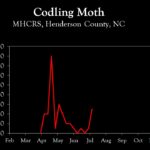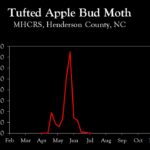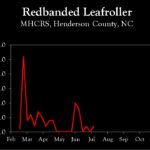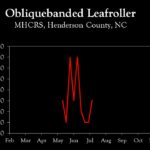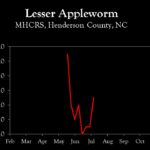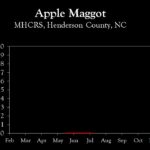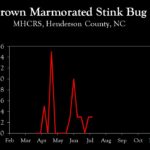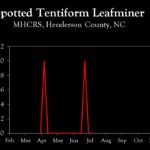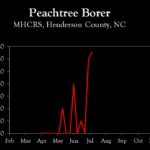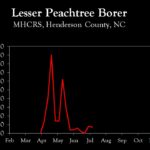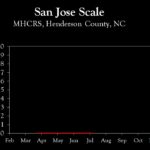WNC Orchard Insect Pest Populations – July 11, 2023
go.ncsu.edu/readext?945030
en Español / em Português
El inglés es el idioma de control de esta página. En la medida en que haya algún conflicto entre la traducción al inglés y la traducción, el inglés prevalece.
Al hacer clic en el enlace de traducción se activa un servicio de traducción gratuito para convertir la página al español. Al igual que con cualquier traducción por Internet, la conversión no es sensible al contexto y puede que no traduzca el texto en su significado original. NC State Extension no garantiza la exactitud del texto traducido. Por favor, tenga en cuenta que algunas aplicaciones y/o servicios pueden no funcionar como se espera cuando se traducen.
Português
Inglês é o idioma de controle desta página. Na medida que haja algum conflito entre o texto original em Inglês e a tradução, o Inglês prevalece.
Ao clicar no link de tradução, um serviço gratuito de tradução será ativado para converter a página para o Português. Como em qualquer tradução pela internet, a conversão não é sensivel ao contexto e pode não ocorrer a tradução para o significado orginal. O serviço de Extensão da Carolina do Norte (NC State Extension) não garante a exatidão do texto traduzido. Por favor, observe que algumas funções ou serviços podem não funcionar como esperado após a tradução.
English
English is the controlling language of this page. To the extent there is any conflict between the English text and the translation, English controls.
Clicking on the translation link activates a free translation service to convert the page to Spanish. As with any Internet translation, the conversion is not context-sensitive and may not translate the text to its original meaning. NC State Extension does not guarantee the accuracy of the translated text. Please note that some applications and/or services may not function as expected when translated.
Collapse ▲ Codling moth populations remain low in the vast majority of orchards, and under those conditions a single insecticide targeting the second generation is recommended at about 1450 DD. Cumulative DD in Henderson County average about 1300 DD as of July 11, and based on the forecast, 1450 will occur on July 15, so we are in that window to consider making an application. In Cleveland County DD accumulations are currently at about 1668, which coincides with 31% hatch of second generation eggs. If an insecticide has not been made against the second generation in the past two weeks in lower elevations, one should be applied as soon as possible. It should be noted that for those using pheromone traps to monitor moths, the need for insecticides should be based on captures in pheromone traps. If no moths are captured, there is obviously no need for insecticides. However, do not make the assumption that populations do not require control if traps are not being used.
Codling moth populations remain low in the vast majority of orchards, and under those conditions a single insecticide targeting the second generation is recommended at about 1450 DD. Cumulative DD in Henderson County average about 1300 DD as of July 11, and based on the forecast, 1450 will occur on July 15, so we are in that window to consider making an application. In Cleveland County DD accumulations are currently at about 1668, which coincides with 31% hatch of second generation eggs. If an insecticide has not been made against the second generation in the past two weeks in lower elevations, one should be applied as soon as possible. It should be noted that for those using pheromone traps to monitor moths, the need for insecticides should be based on captures in pheromone traps. If no moths are captured, there is obviously no need for insecticides. However, do not make the assumption that populations do not require control if traps are not being used.
As mentioned last week, it is doubtful that insecticidal control is needed in orchards using mating disruption.
See last week’s update regarding recommended insecticides and rotations for codling moth control.
Third generation oriental fruit moth is beginning to emerge and lay eggs in Henderson County and similar elevations, but populations of this pest have also been low. However, insecticides applied for codling moth will also control OFM.
European red mites have been quite abundant this year, but it is doubtful that populations will develop to problematic levels in orchards where they have not yet appeared. We have recently sampled in several orchards that have had problems, but populations have already declined in those orchards. Hence, be sure to scout orchards for mites before making miticide applications.
Brown marmorated stink bug populations are considerably delayed compared to previous years, with DD accumulations in Cleveland County at only 580 DD as of July 11. First generation adults begin to emerge at about 750 DD, so we are still 10 to 14 days away from initial emergence in Cleveland County, and probably a month away in Henderson and Wilkes Counties.
Finally, remember that the Mountain Hort Field Day is on Thursday, August 10, at the Mountain Horticultural Crops Research and Extension Center in Mills River. This field day includes several apple presentations in the research orchards as well as talks on tomatoes, vegetables, specialty crops, and alternative crops. More details are in the MHCREC announcement.
Learn more about southeastern apple insect pests at the Apple Insect Management page.
2023 Average Weekly Trap Captures
| HENDERSON COUNTY | |||
| Insects per trap | |||
| June 26 | July 3 | July 10 | |
| Codling moth | 0.0 | 0.5 | 2.5 |
| Oriental fruit moth | 15.0 | 16.0 | 16.0 |
| Tufted apple bud moth | 1.0 | 0.0 | 0.0 |
| Redbanded leafroller | 2.0 | 0.0 | 2.0 |
| Obliquebanded leafroller | 1.0 | 1.0 | 3.0 |
| Lesser appleworm | 1.0 | 1.0 | 5.0 |
| Apple maggot (abandoned and research orchards) | 0.0 | 0.0 | 0.0 |
| Brown marmorated stink bug (commercial) | – | – | – |
| Brown marmorated stink bug (unsprayed) | 0.0 | 0.3 | 0.3 |
| Spotted tentiform leafminer | 1.0 | 1.0 | 0.0 |
| Dogwood borer | 15.0 | 14.0 | 25.0 |
| Peachtree borer | 0.0 | 12.0 | 13.0 |
| Lesser peachtree borer | 0.0 | 4.0 | 3.5 |
| San Jose scale | 0.0 | 0.0 | 0.0 |
*Note that these averages illustrate only the timing of insect emergence and fluctuations in populations, and are not representative of population levels in any given orchard. The only way to have an accurate assessment of an individual orchard’s populations is to set up traps in that orchard.
2023 Accumulated Degree Days
| HENDERSON COUNTY | ||||
| June 26 | July 3 | July 10 | ||
| Codling moth (Biofix: April 7) | 948 | 1107 | 1282 | |
| Oriental fruit moth (Biofix: March 24) | 1478 | 1672 | 1882 | |
| Tufted apple bud moth (Biofix: April 21) | 1124 | 1318 | 1529 | |



